Search our Archives:
» Home
» History
» Holidays
» Humor
» Places
» Thought
» Opinion & Society
» Writings
» Customs
» Misc.
|
Goebbels,
Propaganda and Myth
By Peter
Bjel
This is the third and final article
for the first article click here
for the second article click here
The
lack of tolerance for dissent and individuality was central to Joseph
Goebbels’ propaganda. In the pre-war and wartime periods, Nazi
myths and ideals became reality, underpinning and justifying Nazi
policies, their enactment, and eventual wartime conduct. This is the
third, and final installment, of three articles.
Central to the Third
Reich’s propaganda was the lack of tolerance for dissent and
individuality. So much of its pronouncements and rallying-calls
emphasized the collectivism and unity of Germany, often against
ubiquitous internal and outer derision. It culminated in the Second
World War that, not without a hint of irony, Goebbels’ staff
portrayed as a stepping-stone for Germany’s continental and
global ascension, which had been forced on the country by outside
forces and the ‘Jewish-Bolshevik’ influence. In the
geopolitical realm, pre-war and during wartime, myths and ideals
became reality, underpinning and justifying Nazi policies, their
enactment, and eventual wartime conduct.
* * *
The earliest and most
potent myth that came to justify the Nazis’ seizure of power,
but was exploited repeatedly before then for its wide gravity, was
that of the Versailles Treaty and the November 1918 “stab in
the back,” which led to Germany’s economic and
metaphysical ruin. Such early appropriations of subjects for
propaganda and myth making had the added value of being widespread
and not simply confined to the political lunatic fringe of the German
far right. Post-war Germany was “an ideal incubator for a wide
variety of totalitarian myths,” whereby so many politically
atomized Germans turned to the proverbial security blanket of
totalitarian ideology.1
“All versions of the
myth agreed on the reason for the collapse of this almost perfect
society in the First World war. Germany’s military defeat, and
hence the establishment of the despised republic, was not the result
of military setbacks but a consequence of an international Jewish
politico-financial conspiracy.”2
For the fledgling, but
soon emergent National Socialists, this was the proverbial grist to
their mill, and became a staple myth out of which they found
justification. From this emerged the Third Reich’s eventual
pinpointing of enemies, their presence everywhere, constantly
scheming to destabilize and, ultimately, destroy what had been
created.
Joseph Goebbels partook in
this myth making and scapegoat seeking: “Their policy was one
of attack. Attack represented strength….In any situation,
however adverse, aggression was the rule. On one occasion Goebbels
found a policeman had confiscated his car because it was parked in
front of a hotel entrance. He immediately created a scene, lost his
temper and turned the situation into a public exhibition in which he
called the policeman a Communist and began to incite the people
attracted by the shouting against the government. The result of
this, he boasts, was that the police thenceforth left his car
strictly alone. Aggression pays!”3
As such, “The party,
therefore, was constantly being rallied, and enemies created for it
to fight. The enemies were the government, the Communists and the
Jews.”4
Events and individuals
were morphed into epitomized Nazi ideals, often courtesy of Goebbels
himself. On 11 February 1927, at a beer hall in Pharus-Saele,
Berlin, Goebbels undertook to craft an anti-Communist scheme that
would destabilize the movement, confuse observers so as to have them
question their real political allegiances and channelled resentments,
and to also draw blood. As Joachim Fest has written, “His
[Goebbels’] practice of stirring up fights was the logical
application of a new, completely Machiavellian principle of
propaganda. The blood which the party’s rise cost among its
own members was regarded, not as an inevitable sacrifice in the
struggle for a political conviction, but as a deliberate means of
furthering a political agitation which had recognized that blood
always makes the best headlines.”5
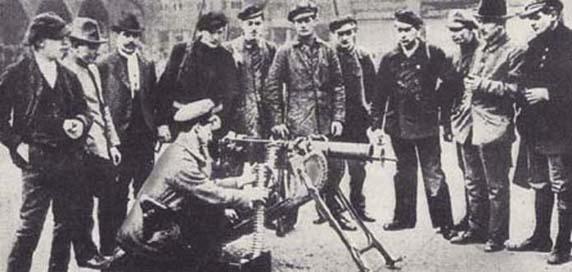
Communist
street fighters, like these ones, were a common sight in Germany
during the early 1920s. The Nazis’ routinely set their sights
on the Communists.
According to Viktor
Reimann, Goebbels then proceeded, after this brawl, to try and carry
on his speech, all the while unnamed wounded SA men were dressed and
bandaged on the platform by him. “Almost the whole Berlin
press gave it front-page coverage….He had given the Berliners
their sensation, and the press was full of it. Goebbels and the
NSDAP [Nazi Party] were the talk of the town.”6
Partly out of these pitted
factious battles emerged not only the theme of self-sacrifice, but
also an undermining of individuality – which had also
manifested as one of the targets in Nazi cultural policy (discussed
in an earlier article). On the whole structures and myths of Nazism,
Fest writes “…the whole arsenal of stimulants, developed
with inventive ingenuity, for exciting public ecstasy was ultimately
intended to bring about the individual’s self-annulment, a
permanent state of mindlessness, with the aim of rendering first the
party adherents and later a whole nation totally amenable to the
leaders’ claim to power.”7
Goebbels’ party
organ Der Angriff propagated the ‘fallen SA’ image
as a laudable sacrifice. One such early figure was Ernst Schwartz.
“Now this devout and committed man, a minister’s son, was
the victim of the Communists, who had brutally murdered him. The
example of Schwartz, the editors of Der Angriff hoped, would
contribute to the myth that storm troopers were ordinary men, making
extraordinary sacrifices for the benefit of Germany.”8
In this same fashion, the paramount instance of myth making and
eulogizing of the Nazi ideal was with the legend of Horst Wessel.9
In reality, Wessel had
been an ordinary SA man and labourer, whose love affair with a
prostitute probably earned him the ire of her pimp, who proceeded to
kill him. Nonetheless, Wessel was an identifiable ideal that
Goebbels knew could be very valuable if tweaked and mythologized.
“For Goebbels, it was insufficient to intone chants over the
bodies of countless SA men. He was convinced that generalities do
not move the masses; only easily identifiable symbols would serve
such a purpose. The agony and death of Horst Wessel, killed by
communists in the winter of 1930, was exactly the theme that the
Gauleiter [i.e. Goebbels] needed to offer his propaganda the unifying
symbol it lacked.”10
Wessel, who expired from
his wounds after five agonizing weeks, became the subject of the
“Horst Wessel Song” (or “Die Fahne hoch,”
meaning “The Flag on High”). It was played at numerous
Nazi Party rallies and at any time that Goebbels sought to invoke the
ethos of heroic self-sacrifice for Fuehrer and Vaterland;
eventually, it became the “official ballad of the NSDAP.”11
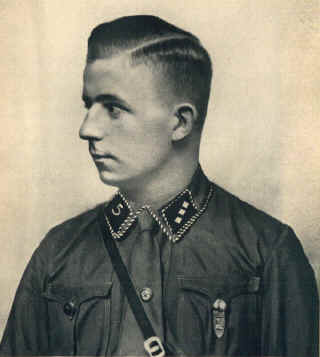
Horst
Wessel (above) became the focus of a concerted myth of heroism and
self-sacrifice.
In the same time period of
the 1920s that Goebbels first became involved with the Nazi Party,
the movement had been driven underground for reasons of legality and
disunity. It had been divided up into regional branches that often
worked incongruously, instead of synonymously. It was a truly
divided house: “The Nazi movement that Hitler confronted on his
release from Landsberg in December 1924 was in a state of decline and
organizational dissolution.” Having realized that an armed
putsch against the Weimar Republic could only end in failure,
Hitler knew that “the old party with its image of a compact
pseudo-military shock troop was not only anachronistic, but, in view
of Hitler’s probationary release from jail, politically
dangerous.”12
It should also be added that, “In November 1923 the NSDAP did
not have this kind of support: it was not an all-German party, and
its organizational distinction from the rest of the Bavarian folkish
movement was not always clear.”13
Yet, when the advantage
had switched to Hitler, Goebbels and company, reality was wilfully
cloaked by myth and propaganda. This period was later collectively
being referred to in reverence as, again, Kampfzeit, or the
“time of struggle.” Upon his release from
prison, Hitler, at the famous Munich Buergerbraeukeller, invoked “the
past unity of the movement,” but failed to mention his
differences with Erich Ludendorff, his trial and imprisonment, and
declared his ultimate personal responsibility for the course of the
Nazi movement, which won him praise, “enthusiastic applause and
cries of Heil.”14
Goebbels mythologized the
figure of Hitler throughout the Third Reich’s twelve years.
“Goebbels accompanied his doctrinal sermons with incessant
adulation of Hitler. Indeed, this was the most important factor in
the creation of the Hitler myth, the invention of the public figure
of the Fuehrer as distinct from Hitler the private person, and in
making it a force for consensus and national unity, first in the Nazi
movement and later in the Third Reich.”15
Dietrich Orlow intimates
in his analysis that it was after this point in Nazi Party history
that there began to be constructed, by Goebbels and company, the
enduring concept and image of the ‘Hitler myth.’ As he
writes: “After the Buergerbraeukeller speech Hitler moved
quickly to convert emotional acceptance of his personification of the
leader myth into concrete, organizational control of those captured
by his charismatic appeal. His method was simple. In effect, he
deliberately repeated his Buergerbraeukeller performance numerous
times as, throughout the spring and summer, he tirelessly appeared at
party section meetings (that is, gatherings restricted to party
members and their guests) in the city….Through these meetings
Hitler quite literally succeeded in solidifying and formalizing the
effects of his charismatic control devices – oral
communication, handshakes, eye-to-eye contact, and the like –
into the members’ personal subordination to his organizational
leadership. He made rapid progress, moreover, in winning over the
membership.”16
Shortly thereafter, the
myth had grown exponentially: “By the end of 1925 Hitler’s
isolationist tactics, his consistent anti-Semitism, and the
publication of his autobiography had securely established his status
in the south as a super leader who fulfilled and embodied the leader
myth….Hitler’s 1923 Putsch became the culmination
of a series of events that began on August 1, 1914. Hitler was the
personification of the German struggle against all enemies, foreign
and domestic, from 1914 to 1923. He was not only the concrete leader
of the future folkish Germany, but his leadership had also given
meaning to the Reich’s past struggles. He was the
twentieth-century leader of the German people.”17
Goebbels worked actively
to create a generic image of Hitler that could appeal to cross-strata
German society, of all ages, emphasizing the “heroic aspect of
his personality. His portrait was a potpourri with something for
everyone.”18
After the Nazi seizure of power, electoral films – as distinct
from the supervised creative work being churned out by the Ministry
of Culture – were tagging this theme of the Hitler myth.
William G. Chrystal
writes: “Hitler is a man who creates his own economics –
and it works. He creates his own foreign policy – and the
Rhineland returns to the Reich. He creates his new armed forces, and
the allies do nothing to stop him. In short, Hitler does exactly
what he promised he would. The March 29, 1936, plebiscite found 99
percent of the votes in his favor.”19
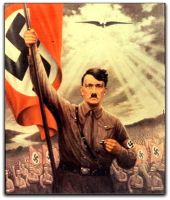
Nazi
propagandists often cast Hitler as a divine-like icon, as this
example shows.
Goebbels was enraptured by
this hallowed Fuehrer, throwing his own cautions and advice to the
wind, even at times as when during the war, real defeat began to loom
on Germany. After the 20 July 1944 Army bomb plot attempt against
Hitler, Goebbels attributed Hitler’s survival to something akin
to Divine Providence.20
The myth was not altogether phoniness, given that Hitler was
extremely lucky in this particular attempt on his life, but it
resonated among many ordinary Germans: “Accordingly it was
women in particular who worshipped him, who fell into ecstasies when
they saw him in person, who even set up a ‘Fuehrer niche’
in their living rooms, with flowers and his picture, in place of the
little religious shrine they would previously have had….In the
eyes of many Germans, Hitler, as a substitute for God, stood above
earthly concerns.”21
In the course of the
Second World War, the Nazis, in their supreme confidence in total and
absolute victory through war, conquest and territorial expansionism,
eventually found themselves seriously overdrawn. It was logical
that, in the winter of 1942-1943, the shattering defeats at the
Battles of Stalingrad and El Alamein shifted the course of the war
against them. For Goebbels, this was an ideological challenge, as
much as it was a practical one, of reconciling a decisive defeat –
specifically at Stalingrad – with the all-purveying myth of
Nazi invincibility.
Hitler himself partook in
this saving-face even before the spectre of defeat loomed on Germany,
instructing journalists that, “Instead of stressing the capture
of localities in and around Stalingrad, they were to emphasize the
bitterness of the fighting and the bravery of the German soldier.
Stalingrad was to be referred to as a fortress which had to be
stormed; if the campaign slowed down, the strength of the Soviet
fortifications would serve as a ready excuse.”22
In late October 1942, the
SS paper Das Schwarze Korps portrayed the Soviet Red Army’s
resilience and strength in racial and bestial terms. “The
Bolsheviks on the other hand refused to realize when a struggle was
useless, and continued to fight to the last man. Thus Stalingrad
represented the quintessence of the Soviet contempt for the human
race.”23
When the freezing cold defeat did become clear, Hitler gave Goebbels
permission to disclose this truth, but to keep dramatizing “the
heroism and self-sacrifice of the men at Stalingrad in order to urge
a more dedicated war effort on the German home front,” and that
“An entire Army had sacrificed itself ‘for all of us,’
and indeed, for western civilization. Goethe and Beethoven, Augustus
and Pericles were being defended in the wilds of the East.”24
It was saving face, in light of military disaster, through the craft
of myth making.25
Only as the war came home
to the Third Reich’s capital did the edifice of propaganda,
myth and illusion, honed and constructed wilfully by Goebbels, begin
to fall apart like a row of dominoes. When, in April 1945, this
apparatus fell apart, its parent regime’s fate was not long in
following. After the 20 July bomb plot on Hitler, Goebbels finally
was given the title Minister for Total War. Even in his
time-honoured capacity for delivering the tasks Hitler so demanded,
the war made his new portfolio completely useless, but for delaying
the inevitable for a few months’ longer.
In the same fashion as the
Horst Wessel sacrifice, Goebbels justified the destruction of Germany
brought on by Hitler’s policies – now a target, after
1943 especially, of routine Allied carpet bombings – by first
promising retaliation, or Vergeltung, which became a staple of
his propaganda after 1943. It then began dying out for its
incongruity, laughable mythologizing of the V-1 and V-2 rockets’
effectiveness, “Unrestrained exaggeration and downright
dishonesty…”26
When this promise fell through, he seized on faith in Hitler, and in
the spirit of resistance: “But for us it has always been a
fixed and immutable principle that the word capitulation does not
exist in our vocabulary!…We have faith in victory because we
have the Fuehrer!…Faith can move mountains! This
mountain-moving faith must fill our hearts!”27

A photo
of the V-2 rocket, sometime in 1945. Goebbels attempted to
mythologize the V-2 capability in the final period of World War II.
“By 1944 Goebbels
was making propaganda as much for himself and the leadership as for
the masses: It was a consolation in the midst of despair and
destruction.”28
In the final weeks of April 1945, Goebbels tried to make the most
out of the groups of resistance fighters, known as ‘Werewolves,’
defending the Reich capital and executing any pacifists or defeatists
that they found, but like Hitler’s strategic scope, the reality
was actually sorrier than the figures on paper.29
Thus, unity, myth,
ubiquitous enemies and war came to underpin, by Goebbels’
machinations, the scope of Nazi geopolitics, stretching from the
period of Hitler’s release from prison, to the final days of
the Third Reich. In its essence, it was a phenomenon that involved
making real that which was not, and vice-versa, in the underpinning
of Nazi geopolitical conduct and function.
In his desperation and
secluded isolation, awaiting the moment that he would be deported to
a dark but uncertain place, Victor Klemperer, an academic before the
war (and a Jew by birth, who later became a Protestant), meticulously
kept a diary that fulfilled his own need to resist Hitler the only
way that he could. At the risk of death if discovered, he also
chronicled in its pages how he secretly worked on a manuscript
entitled LTI (Lingua tertii imperii), dealing with
language usage and the deliberate, common literary and figurative
metamorphoses taking place at the hands of the Nazis, transforming,
for example, words ordinarily denoting vices into Nazi-extolled
virtues. Essentially, Klemperer documented the constant and wilful
twisting of reality taking place around him. The all-pervasive
presence of Goebbels figures throughout his diary from 1942-1945.30
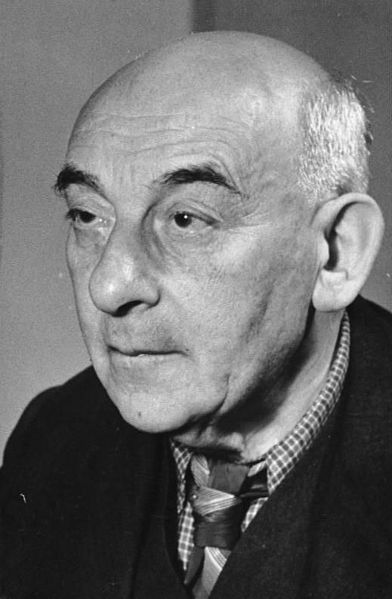
Victor
Klemperer, circa 1952
Klemperer was one of the
lucky Jews (irrespective of how he viewed himself) to survive the
Third Reich. So many others did not, whose forced emigration and,
eventually, isolation, vulnerability and murder were spurred on and
justified in no small measure by Goebbels’ own opportunistic
anti-Semitism and propaganda, which held out even though it proved to
be a shaky foundation in the Third Reich’s dying days. “All
his attempts to paint the universal enemy as a wirepuller at work
from Moscow to Wall Street were shattered by the reality of the
frightened and harassed human beings wearing the yellow star, who for
a time wandered the streets of German cities before suddenly
vanishing forever.”31
Consistently vilified and
vilely demonized in propaganda, popular culture, official ideology,
the November 1938 Kristallnacht pogroms, and foreign policy
(the Nazis’ other war), the image of ‘Der Ewige Jude,’
the ‘Eternal Jew,’ to not speak of the boosts provided by
the film of the same name, led straight to the “Final
Solution.” This was the culmination and ultimate price paid by
Goebbels’ misanthropy-turned-opportunism.
***
As Nazi propaganda was born by Goebbels,
so too did it die with him. His final days were spent in Berlin,
where he partook in the Reich Chancellery bunker’s macabre
final events that characterized the end of the Third Reich. Up to
the very end, he and his dwindling number of staffers had kept
churning out radio broadcasts and editorials in Das Reich,
glorifying and edifying self-sacrifice, heroic resistance, and
perseverance to a time when war, the conglomerate of international
Jewry and Bolshevism would be a thing of the past, the Greater German
Reich resurrected, and the Fuehrer back to where he rightfully began
his unfinished mandate.
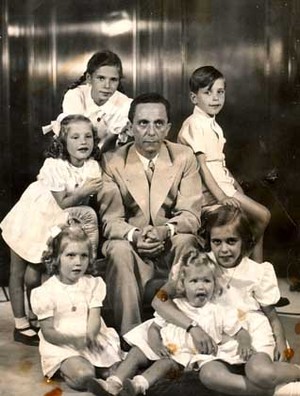
Goebbels and his six
children. He and his wife poisoned them before aving themselves shot
outside Hitler’s bunker on the evening of 1 May 1945.
His last article in Das Reich was,
predictably, entitled “Resistance at Any Cost,” and the
only factor that stopped him from propagating it was because the
paper could not be distributed.32
Along with his wife and six children, he joined Hitler and the
remaining Nazi entourage in the bunker beneath the wrecked
Chancellery, where Goebbels partook in Hitler’s final birthday
celebration on 20 April and, nine days later, was a formal witness to
his marriage to Eva Bruan, and co-signed his last will and testament.
Two days later, on the evening of 1 May, Goebbels mimicked Hitler’s
conduct by having himself and his wife shot by an SS orderly –
but not before they had their six children poisoned as they slept.33
To restate matters, the uses of ubiquitous
propaganda were crucial for Nazi rule; Nazi propaganda was a
masquerade and disseminator of Nazi ideology, without which the
events and manifestations emanating from the Third Reich could not
have happened. The scope and unprecedented apparatus of the Nazi
system of propaganda distinctively owed its genesis to Goebbels, who
crucially went about creatively and subtly disseminating the Nazi
ethos via cultural routes. There were scarcely any remaining
cultural avenues left that had not been touched by him. To underpin
Nazi geopolitics, and all the policies that figured from this realm,
propaganda and the creation of myths transformed the unreal into
reality and justified Nazi policies and conduct; when warfare came
smashing into the centre of the Third Reich, so too was Goebbels’
system smashed.
On the surface, it is hard
to believe that so much of the Nazi phenomenon owes its manifestation
to Goebbels. While it did not emanate solely from him, he was the
link, the “practitioner and technician” of totalitarian
rule that Hitler seized upon to carry forth Nazism. “Until he
discovered Hitler, he [Goebbels] lived in a void, clutching at
changing ideologies, feeding on nihilism and resentment.”34
The negativity lingered on well past his discovery of Hitler and
Nazism; the legacies of this still live.
* * * * *
- Peter Bjel is a
freelance writer and teacher candidate, and holds degrees in Politics
and History from the University of Toronto. He can be reached at
peterbjel@hotmail.com.
This is the final third of three articles about Goebbels, propaganda
and the Third Reich.
NOTES:
1
Dietrich Orlow, “The Conversion of Myths into Political Power:
The Case of the Nazi Party, 1925-1926.” The American
Historical Review 72, 3 (April 1967): pp. 906-924, at pp.
906-907.
3
Roger Manvell and Heinrich Fraenkel, Dr. Goebbels: His Life and
Death (New York: Simon and Schuster, 1960), p. 107.
5
Joachim C. Fest, The Face of the Third Reich (New York:
Pantheon Books, 1970), p. 90.
6
Viktor Reimann, Goebbels: The Man Who Created Hitler (Garden
City, NY: Doubleday, 1976), pp. 76-77. He adds: “Goebbels’
conquest of Berlin began with the battle in the Pharus-Saele. He
had become known, he had gathered the activist party members around
him, he had strengthened their fighting morale and whetted their
aggressive appetites. They had tasted blood” (p. 77).
7
Fest, The Face of the Third Reich, p. 83.
8
Russell Lemmons, Goebbels and ‘Der Angriff’
(Lexington: University Press of Kentucky, 1994), p. 67.
9
For full accounts of the Wessel affair, the details and motives
behind his murder, and its conversion to Nazi myth, see Ibid., pp.
71-75; Reimann, Goebbels, p. 117; and Ralf Georg Reuth,
Goebbels: A Biography (New York: Harcourt Brace &
Company, 1993), pp. 110-113.
10
Jay W. Baird, “Goebbels, Horst Wessel, and the Myth of
Resurrection and Return.” Journal of Contemporary History
17, 4 (October 1982): pp. 633-650, at p. 634.
11
Lemmons, Goebbels and ‘Der Angriff,’ pp. 71-72.
For more on the myth and its manifestations, see Baird, “Goebbels,
Horst Wessel, and the Myth of Resurrection and Return.”
12
Orlow, “The Conversion of Myths into Political Power,”
p. 910.
14
Ibid., pp. 912-913, for details.
15
Gordon A. Craig, “The True Believer.” New York Review
of Books 41, 6 (24 March 1994), HTML.
16
Orlow, “The Conversion of Myths into Political Power,”
p. 913.
18
Herzstein, The War that Hitler Won, p. 54.
19
Chrystal, “Nazi Party Election Films,” p. 43.
20
Reuth, Goebbels, p. 333, on the pseudo-religious portrayal of
Hitler’s survival. On throwing caution to the wind, see pp.
291-292, for example. See also Reimann, Goebbels, pp.
294-295.
21
Ibid., p. 232. The literature on the 20 July 1944 attempt on
Hitler’s life, and on the German Resistance itself, is growing
steadily. A good start – by this author’s
recommendation – is Joachim Fest, Plotting Hitler’s
Death: The Story of the German Resistance (New York: Owl Books,
1997). It chronicles not only the circumstances leading to 20 July,
but tells the story of the German Resistance from the beginning –
including its broader failures and constant ineptness to stop Hitler
and the Nazis.
22
Jay W. Baird, “The Myth of Stalingrad.” Journal of
Contemporary History 4, 3 (July 1969): pp. 187-204, at p. 189.
25
Baird writes: “Hitler and Goebbels realized that the
propaganda coverage of the disaster had to be treated in an
extraordinary fashion. Neither factual reporting nor traditional
misrepresentation would serve their purpose, and they decided that
the sacrifice along the Volga could be explained only by way of a
myth. Reality was thus to be reinterpreted” (Ibid., pp.
197-198).
26
See Gerald Kirwin, “Waiting for Retaliation: A Study in Nazi
Propaganda Behaviour and German Civilian Morale.” Journal
of Contemporary History 16, 3 (July 1981):
pp. 565-583, at pp. 566, 576, 579, for these points.
27
Quoted in Reuth, Goebbels, p. 313.
28
Robert E. Herzstein, The War that Hitler Won: The Most Infamous
Propaganda Campaign in History (New York: G.P. Putnam’s
Sons, 1978), p. 107.
29
Manvell and Fraenkel, Dr. Goebbels, p. 252, on details of the
‘Werewolf’ propaganda.
30
See Victor Klemperer, I Will Bear Witness, 1942-1945: A Diary of
the Nazi Years (New York: Modern Library, 2001).
31
Fest, The Face of the Third Reich, p. 94.
32
On this, see Reuth, Goebbels, p. 355.
33
See H. R. Trevor-Roper, The Last Days of Hitler (New York:
Macmillan Company, 1947), pp. 212-214, on the description of the
Goebbels’ deaths. A more recent analysis of those final days
is Joachim Fest, Inside Hitler’s Bunker: The Last Days of
the Third Reich (New York: Farrar, Strauss and Giroux, 2004),
pp. 141-146 (for the death of Goebbels).
34
Hugh Trevor-Roper, “Hitler’s Impresario.” New
York Review of Books 25, 9 (1 June 1978), HTML.
~~~~~~~
from the December 2011 Edition of the Jewish Magazine
Material and Opinions in all Jewish Magazine articles are the sole responsibility of the author; the Jewish Magazine accepts no liability for material used.
|
|
Please let us know if you see something unsavory on the Google Ads and we will have them removed. Email us with the offensive URL (www.something.com)
|





|